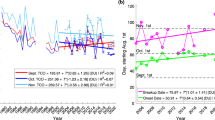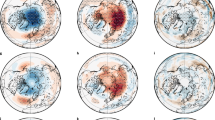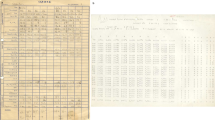Abstract
IN 1985, Farman et al.1 announced that a dramatic reduction in total ozone was occurring in the atmosphere over Halley, Antarctica, during the polar spring. Analysis of satellite data revealed that this ozone depletion was an Antarctic-wide phenomenon2. Combined theoretical3á¤-5, observational6,7 and laboratory8 work has shown that chlorine radicals derived from the photolysis of chlorofluorocarbons were the dominant cause of the ozone loss9á¤-11. Ten years later, we review here the status of the 'ozone hole' based on the continued total-ozone measurements at Halley. The springtime ᤘozone holeᤙ continues to deepen, with both the October mean and minimum total ozone persistently decreasing. The ozone loss extends into January and February, so that significant increases in ultraviolet-B radiation can be expected at the surface over Antarctica during the summer. A signal of ozone loss is now apparent in the spring and summer temperature records, with recent temperatures at the 100-mbar level consistently close to, or colder than, the historical (1957á¤-72) minima for the period October to January. These low temperatures may well enable the maintenance of springtime ozone-loss mechanisms until later in the year.
This is a preview of subscription content, access via your institution
Access options
Subscribe to this journal
Receive 51 print issues and online access
$199.00 per year
only $3.90 per issue
Buy this article
- Purchase on Springer Link
- Instant access to full article PDF
Prices may be subject to local taxes which are calculated during checkout
Similar content being viewed by others
References
Farman, J. C., Gardiner, B. G. & Shanklin, J. D. Nature 315, 207–210 (1985).
Stolarski, R. S. et al. Nature 322, 808–811 (1986).
Solomon, S., Garcia, R. R., Rowland, F. S. & Wuebbles, D. J. Nature 321, 755–758 (1986).
McElroy, M. B., Salawitch, R. J., Wofsy, S. C. & Logan, J. A. Nature 321, 759–762 (1986).
Molina, L. T. & Molina, M. J. J. phys. Chem. 91, 433–436 (1986).
Anderson, J. G., Brune, W. H. & Proffitt, M. H. J. geophys. Res. 94, 11465–11479 (1989).
de Zafra, R. L. et al. Nature 328, 408–411 (1987).
Hayman, G. D., Davies, J. M. & Cox, R. A. Geophys. Res. Lett. 13, 1347–1350 (1986).
Solomon, S. Nature 347, 347–354 (1990).
Scientific Assessment of Stratospheric Ozone: 1989 (Rep. No. 20, World Meteorological Organization Global Ozone Research and Monitoring Project, WMO, Geneva, 1990).
Scientific Assessment of Ozone Depletion: 1991 (Rep. No. 25, World Meteorological Organization Global Ozone Research and Monitoring Project, WMO, Geneva, 1992).
Farman, J. C. & Hamilton, R. A. Scientific Rep. No. 90 (British Antarctic Survey, Cambridge, UK, 1975).
Hofmann, D. J., Harder, J. W., Rosen, J. M., Hereford, J. V. & Carpenter, J. R. J. geophys. Res. 94, 16527–16536 (1989).
Deshler, T., Hofmann, D. J. & Hereford, J. V. J. geophys. Res. 95, 10023–10035 (1990).
Hofmann, D. J. & Oltmans, S. J. J. geophys. Res. 98, 18555–18561 (1993).
Cariolle, D., Lasserre-Bigorry, A., Royer, J.-F. & Geleyn, J.-F. J. geophys. Res. 95, 1883–1898 (1990).
Prather, M., Garcia, M. M., Suozzo, R. & Rind, D. J. geophys. Res. 95, 3449–3471 (1990).
Mahlman, J. D., Pinto, J. P. & Umsheid, L. J. J. atmos. Sci. 51, 489–508 (1994).
Booth, C. R. & Madronich, S. in Ultraviolet Radiation in Antarctica: Measurements and Biological Research (eds Weiler, C. S. & Penhale, P. A.) 39–42 (Antarctic Res. Ser. 62, American Geophysical Union, Washington DC, 1994).
Shine, K. P. Geophys. Res. Lett. 13, 1331–1334 (1986).
Kiehl, J. T., Boville, B. A. & Briegleb, B. P. Nature 332, 501–504 (1988).
van Loon, H. & Labitzke, K. Mon. Weath. Rev. 115, 357–369 (1987).
Poole, L. R., Solomon, S., McCormick, M. P. & Pitts, M. C. Geophys. Res. Lett. 16, 1157–1160 (1989).
Nichol, S. E., Coulmann, S. & Clarkson, T. S. Geophys. Res. Lett. 18, 1865–1868 (1991).
Toon, O. B. & Tolbert, M. A. Nature 375, 218–221 (1995).
Carslaw, K. S. et al. Geophys. Res. Lett. 21, 2479–2482 (1994).
Garcia, R. R. & Solomon, S. Geophys. Res. Lett. 14, 848–851 (1987).
Solomon, S. & Wuebbles, D. in Scientific Assessment of Ozone Depletion: 1994 (Rep. No. 37, WMO, Geneva, 1995).
Hofmann, D. J. & Oltmans, S. J. J. geophys. Res. 98, 18555–18561 (1993).
Hofmann, D. J., Oltmans, S. J., Lathrop, J. A. & Vömel, H. Geophys. Res. Lett. 21, 421–424 (1994).
Fels, S. B., Mahlman, J. D., Schwarzkopf, M. D. & Sinclair, R. W. J. atmos. Sci. 37, 2265–2297 (1980).
Author information
Authors and Affiliations
Rights and permissions
About this article
Cite this article
Jones, A., Shanklin, J. Continued decline of total ozone over Halley, Antarctica, since 1985. Nature 376, 409–411 (1995). https://doi.org/10.1038/376409a0
Received:
Accepted:
Issue Date:
DOI: https://doi.org/10.1038/376409a0
This article is cited by
-
Changes in Phenolic Compounds and Cellular Ultrastructure of Arctic and Antarctic Strains of Zygnema (Zygnematophyceae, Streptophyta) after Exposure to Experimentally Enhanced UV to PAR Ratio
Microbial Ecology (2013)
-
Sunlight effects on the DMSP-sulfur and leucine assimilation activities of polar heterotrophic bacterioplankton
Biogeochemistry (2012)
-
Divergences in the Response to Ultraviolet Radiation Between Polar and Non-Polar Ciliated Protozoa
Microbial Ecology (2012)
-
Effects of enhanced UV-B radiation on nitrogen fixation in arctic ecosystems
Plant Ecology (2006)
Comments
By submitting a comment you agree to abide by our Terms and Community Guidelines. If you find something abusive or that does not comply with our terms or guidelines please flag it as inappropriate.



